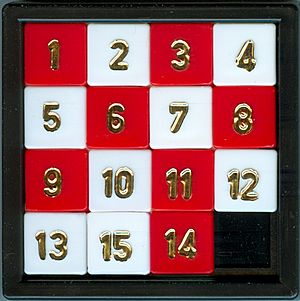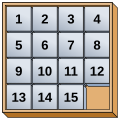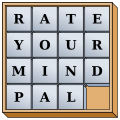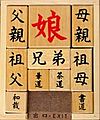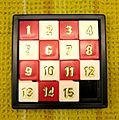Sliding puzzle facts for kids
A sliding puzzle is a type of game where you slide flat pieces around on a board. Your goal is to move the pieces into a certain order or to complete a picture. Imagine a jigsaw puzzle, but instead of picking up the pieces, you can only slide them!
The pieces in these puzzles can be simple shapes, or they might have colors, patterns, parts of a bigger picture, numbers, or letters on them. Even if the pieces are connected by mechanics, like marbles in a track, the puzzle is still mostly about moving things in two dimensions (flat on a surface).
What makes sliding puzzles special is that you can't lift any piece off the board. You can only slide them into empty spaces or along specific paths. This is different from other puzzles where you might pick up and rearrange pieces. So, figuring out where to move each piece and what paths open up is a big part of solving these puzzles.
History of Sliding Puzzles
The very first type of sliding puzzle was the Fifteen puzzle. It was invented by Noyes Chapman in 1880. Many people often mistakenly give credit to Sam Loyd for inventing it, but that's not true. Chapman's invention started a huge puzzle craze in the early 1880s!
From the 1950s to the 1980s, sliding puzzles that used letters to form words became very popular. These puzzles often had many possible solutions. Some examples include Ro-Let, Scribe-o, and Lingo.
The Fifteen puzzle has even been made into computer games. You can find many versions to play online for free! These computer versions are a bit like jigsaw puzzles because your goal is often to form a picture on the screen. Once you line up all the pieces, the last square of the puzzle usually appears automatically.
Gallery
-
An example of the Klotski puzzle
Examples of Sliding Puzzles
Here are some well-known sliding puzzles:
Images for kids
See also
 In Spanish: Rompecabezas deslizantes para niños
In Spanish: Rompecabezas deslizantes para niños


